利用边缘检测确定梁的旋转,分析疲劳载荷条件下连接节点的j积分
IF 6.8
2区 材料科学
Q1 ENGINEERING, MECHANICAL
引用次数: 0
摘要
提出了一种用于疲劳加载双悬臂梁(DCB)试件载荷点旋转分析和j积分计算的边缘检测方法。在疲劳试验中,获得了背光DCB试样在最大载荷点位移下的图像。使用图像处理算法评估负载点旋转。分析涉及二值化、对齐和边缘检测。为了验证该方法,将基于图像分析的j积分值与线性弹性断裂力学(LEFM)方法(包括柔度校准和弹性基础模型)进行了比较。在23 - 80°C的恒定振幅或恒定应变能释放率(SERR)疲劳载荷下,测试了三种层压系统,包括软(乙烯醋酸乙烯共聚物,EVA)、结构(丙烯酸,DP8810)和脆性(丙烯酸,Kisling 2206)粘合剂。在位移控制下,使用软胶的玻璃/EVA层压板的j积分方法与LEFM方法没有显著差异。然而,在SERR控制下,在恒定SERR为75 J/m2和80°C时,J积分值降低了20%。断口分析显示,位移控制下界面破坏为主,SERR控制下黏聚破坏为主。在位移和serr控制下,与结构丙烯酸胶粘剂粘合的铝/DP8810层压板的j积分和LEFM结果之间没有显着偏差。两种加载条件下的破坏均为内聚破坏。脆性电工钢/丙烯酸层压板也观察到类似的行为。在位移控制下,没有发现偏差。基于边缘检测的方法能够在没有符合性校准或材料参数的情况下准确、高效地确定j积分,减少了误差来源,并扩大了对涉及大损伤区域和弹塑性粘合行为的情况的适用性。本文章由计算机程序翻译,如有差异,请以英文原文为准。

Analyzing the J-integral of bonded joints under fatigue loading conditions by determining beam rotations with edge detection
This study presents an edge detection method for analyzing load point rotations and evaluating the J-integral in fatigue-loaded double cantilever beam (DCB) specimens. Images of backlit DCB specimens were captured at maximum load point displacement during fatigue tests. Load point rotation was assessed using an image processing algorithm. The analysis involved binarization, alignment, and edge detection. To validate the approach, J-integral values from image-based analysis were compared with linear elastic fracture mechanics (LEFM) methods, including compliance calibration and elastic foundation models. Three laminate systems, incorporating soft (ethylene vinyl acetate copolymer, EVA), structural (acrylic, DP8810), and brittle (acrylic, Kisling 2206) adhesives were tested under constant amplitude or constant strain energy release rate (SERR) fatigue loading at temperatures ranging from 23 to 80°C.
Glass/EVA laminates with a soft adhesive showed no significant difference between J-integral and LEFM methods under displacement control. However, under SERR control, J-integral values were up to 20 % lower at a constant SERR of 75 J/m2 and 80 °C. Fractographic analysis revealed predominantly interfacial failure under displacement control and cohesive failure under SERR control. Aluminum/DP8810 laminates bonded with a structural acrylic adhesive exhibited no significant deviations between J-integral and LEFM results under both, displacement- and SERR-control. Failure was cohesive under both loading conditions. Similar behavior was observed for brittle electrical steel/acrylic laminates. No deviations were discernible under displacement control.
The edge detection-based approach enabled accurate, efficient J-integral determination without compliance calibration or material parameters, reducing error sources and broadening applicability to cases involving large damage zones and elastic–plastic adhesive behavior.
求助全文
通过发布文献求助,成功后即可免费获取论文全文。
去求助
来源期刊

International Journal of Fatigue
工程技术-材料科学:综合
CiteScore
10.70
自引率
21.70%
发文量
619
审稿时长
58 days
期刊介绍:
Typical subjects discussed in International Journal of Fatigue address:
Novel fatigue testing and characterization methods (new kinds of fatigue tests, critical evaluation of existing methods, in situ measurement of fatigue degradation, non-contact field measurements)
Multiaxial fatigue and complex loading effects of materials and structures, exploring state-of-the-art concepts in degradation under cyclic loading
Fatigue in the very high cycle regime, including failure mode transitions from surface to subsurface, effects of surface treatment, processing, and loading conditions
Modeling (including degradation processes and related driving forces, multiscale/multi-resolution methods, computational hierarchical and concurrent methods for coupled component and material responses, novel methods for notch root analysis, fracture mechanics, damage mechanics, crack growth kinetics, life prediction and durability, and prediction of stochastic fatigue behavior reflecting microstructure and service conditions)
Models for early stages of fatigue crack formation and growth that explicitly consider microstructure and relevant materials science aspects
Understanding the influence or manufacturing and processing route on fatigue degradation, and embedding this understanding in more predictive schemes for mitigation and design against fatigue
Prognosis and damage state awareness (including sensors, monitoring, methodology, interactive control, accelerated methods, data interpretation)
Applications of technologies associated with fatigue and their implications for structural integrity and reliability. This includes issues related to design, operation and maintenance, i.e., life cycle engineering
Smart materials and structures that can sense and mitigate fatigue degradation
Fatigue of devices and structures at small scales, including effects of process route and surfaces/interfaces.
 求助内容:
求助内容: 应助结果提醒方式:
应助结果提醒方式:


